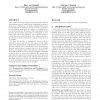Free Online Productivity Tools
i2Speak
i2Symbol
i2OCR
iTex2Img
iWeb2Print
iWeb2Shot
i2Type
iPdf2Split
iPdf2Merge
i2Bopomofo
i2Arabic
i2Style
i2Image
i2PDF
iLatex2Rtf
Sci2ools
82
Voted
COMPGEOM
2009
ACM
2009
ACM
Embedding rivers in polyhedral terrains
Data conflation is a major issue in GIS: spatial data obtained from different sources, using different acquisition techniques, needs to be combined into one single consistent data set before the data can be analyzed. The most common occurrence for hydrological applications is conflation of a digital elevation model and rivers. We assume that a polyhedral terrain is given, and a subset of its edges are designated as river edges, each with a flow direction. The goal is to obtain a terrain where the rivers flow along valley edges, in the specified direction, while preserving the original terrain as much as possible. We study the problem of changing the elevations of the vertices to ensure that all the river edges become valley edges, while minimizing the total elevation change. We show that this problem can be solved using linear programming. However, several types of artifacts can occur in an optimal solution. We analyze which other criteria, relevant for hydrological application...
| Added | 28 May 2010 |
| Updated | 28 May 2010 |
| Type | Conference |
| Year | 2009 |
| Where | COMPGEOM |
| Authors | Marc J. van Kreveld, Rodrigo I. Silveira |
Comments (0)

